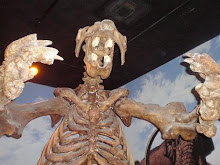

One of my favorite snacks is the Hershey's milk chocolate bar. I have always wondered just how environmentally safe it was, being aware of course of how unhealthy they are as a food item. I recall seeing on the back of a Mar's M&M's wrapper one time that they had a seal that guaranteed that the chocolate was produced with sustainability in mind, but in recent times I have not seen this seal. But as far as chocolate goes, Hershey is usually my choice.
I visited a page on the Hershey website - www.hersheys.com/discover/chocolate.asp# - and found some basic information. On this page, the company discusses how the chocolate is processed from the cacao beans found in places such as Brazil, Indonesia, The Ivory Coast, and Ghana, although when I called Hershey, Venezuela, The Dominican Republic, and Ecuador were also part of that list (as well as other places). The seeds are taken from pods that grow on the cacao tree, then the beans are transported by boat and then by railroad to the factories. The Hershey's representative that I spoke with on the phone told me that 90% of the factories were in either the United States or Canada, and some were located in Mexico.
The Hershey website goes on to explain that once the seeds are brought to the factories, they are cleaned and stored. Beans from different countries have different flavors and are kept separate. From what I gathered from the information on the page, the beans are added probably on the basis of some sort of ratio for each country, and this is what gives "that special Hershey taste." The web page continues by saying that the beans are roasted and the inner part or "nib" is what is actually used in the production of chocolate.
The cacao beans are where Hershey gets two of the main ingredients for its milk chocolate bars - the cocoa butter and chocolate liquor. The representative I spoke with enlightened me a little further as to where the sugar is acquired. She told me that any beat sugar that is used is from North Dakota, and the sugar from sugar cane is taken from Florida, Hawaii, and South America. The website mentions that the milk component is fresh whole milk that has been tested and pasteurized at the factory.
On the topic of Genetically Modified Organisms (GMO), the Hershey representative gave me a whole speech that seemed to be a disclaimer. However, some of the key things that she stated were that any GMO's in the chocolate were safe to consume and that there may only be GMO's in the soy, and canola components. Sugar, she said, may be genetically modified in the future. Her explanation for why the soy and canola may have GMO's is that it is difficult to separate out GMO's from commodities such as those.
I have seen organic chocolate many times before, so Hershey's excuses may not be good, but I can somewhat understand how it would be more expensive for the company and consumers if Hershey only used non-GMO soy and canola. Also, as was the topic of the case with Monsanto in "Future of Food", it may be incredibly difficult to find non-GMO varieties of these commodities if the altered seeds are being dispersed all over the place. Hershey could do it, I think, as they are a huge company, but there are definitely pros and cons that must be weighed. GMO's themselves aren't necessarily bad, I am to understand, the problem is when companies like Monsanto try to monopolize the patented seeds.
Through further research, notably at this website -http://news.bbc.co.uk/2/hi/science/nature/7474278.stm - I learned that Mars was working to decode the genetics of the cacao plant in order to use genetic engineering to make the plant resistant to disease, pests, and water shortages. According to this article, which was published by the BBC in June of 2008, it would take five years to crack the code, therefore it should still be under way. This information indirectly shows that cacao trees have not been modified up until this point, which is nice to know.
In addition, I definitely believe that people should have access to a food's list of ingredients and nutritional information. Just as with cigarettes, there should be warnings, which for food would include information about any GMO ingredients in the food.







 The "appropriate technology" concept can also be observed with this tractor tire, which has been converted into a tree pot:
The "appropriate technology" concept can also be observed with this tractor tire, which has been converted into a tree pot: I learned that vulcanized rubber tires are very tough and
I learned that vulcanized rubber tires are very tough and  This type of climate is of particular interest to me, because I am fascinated by the Andean Mountain Range of South America, where this type of environment is abundant. However, I had no idea that stones were used to terrace the mountainsides.
This type of climate is of particular interest to me, because I am fascinated by the Andean Mountain Range of South America, where this type of environment is abundant. However, I had no idea that stones were used to terrace the mountainsides. The
The 

